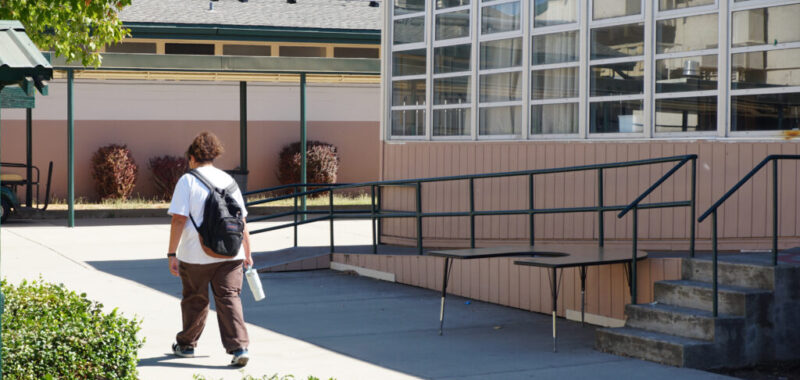From securing school entrances to making campuses more resilient to climate change, districts throughout the state are looking to voters to upgrade their facilities.
An EdSource Roundtable on Tuesday, “Election 2024: How voters can help repair California schools,” discussed what a $10 billion state bond and $50 billion in local construction bonds on the November ballot could make possible.
“To make the choice of going to an uncomfortable learning condition in our schools, or to stay at home … .is a choice that students should not have to make,” San Lorenzo Unified Superintendent Daryl Camp said during Tuesday’s discussion. “Students should be able to learn in an environment that’s comfortable for learning.”
Funding for school facilities
This November, California voters will decide whether to support school districts getting money for facilities through two avenues: a $10 billion state bond and, depending on individual location, a local bond measure.
State construction bonds require a 50% majority to pass, while local bonds need 55% of the vote.
The statewide bond — which would be approved by voters passing Proposition 2 — would give $8.5 billion to K-12 schools and another $1.5 billion to California’s community colleges. Voters haven’t passed a bond of its kind since 2016.
Of the funds for K-12 schools, $4 billion will be allocated toward modernizing, retrofitting and rehabilitating buildings, according to Sara Hinkley, the California program manager at UC Berkeley’s Center for Cities and Schools. Meanwhile, $3.3 billion would go toward new construction, and smaller amounts are designated for charter schools and career technical education.
But according to Hinkley, the vast majority of funding for school facilities in California comes from local bond measures.
Districts can also apply to have the California School Facilities Program match those funds on a project basis, but that money is set to expire in early 2025 unless voters pass Proposition 2 to add funding to it for the first time in eight years.
“I know a lot of districts have put measures on the ballot in November in hopes of being able to apply for and secure some of that state funding,” Hinkley said at Tuesday’s discussion. “And for a lot of districts, that is really the only way they’re going to be able to fund some of these projects.”
The difference bonds could make
Del Norte Unified School District has a motto: Keep the wet out.
In 1964, the district’s schools were rebuilt following a tsunami and flood. Now, Brie Fraley, a district parent who was on Tuesday’s panel, said some of the schools have leaky roofs and open ceilings.
It has been 16 years since the district in the state’s far north had a bond measure on the ballot — and Fraley is concerned about the lack of support so far.
“Unfortunately, we did a poll, and the majority of the community members here are not in favor of Measure 8 that the school board trustees are putting on the ballot,” Fraley said. “So I’m really concerned about access to statewide resources if our community isn’t supportive of it.”
Many districts have already benefited from passing local bond measures, the panelists agreed.
As a result of poor infrastructure and frequent break-ins, Hallie Lozano, a panelist who is a literacy coach at Dyer-Kelly Elementary in Sacramento County’s San Juan Unified, said their school was completely rebuilt after input from teachers, families and students.
They made the school entirely indoors, built it so visitors had to check in at the front office, added spaces for counselors and other interventionists and ensured there were enough bathrooms.
“It makes you feel more valued as a professional,” Lozano said during Tuesday’s discussion. “I think it makes students feel more valued as students, and the families recognize that we’re really giving everything we can to our students and the community.”
She added that the upgrades have also helped with teacher retention.
“Every year, somebody was leaving, or a few people were leaving,” she said. “And now we rarely have people leave unless there’s a promotion, or somebody’s moving out of the area. But it’s not something that happens like it did.”
Sara Noguchi, the superintendent of Modesto City Schools, said the local bond measure would help the district upgrade the 50- to 90-year-old facilities to 21st century standards.
At San Lorenzo Unified, Superintendent Camp is hoping voters pass a local bond measure to help bring air conditioning to its schools amid rising temperatures — in addition to safety and technological upgrades.
“The climate situation is real. It’s apparent. I feel it every day I visit classes, especially on the heat wave,” he said. “It’s not every day, but the days that it’s hot, I have to say, yeah, it’s a challenge getting students to be there and to stay there.”
Other considerations
As voters decide whether to pass their state and local bonds, superintendents have to weigh their schools’ needs with declining enrollments.
But Camp said a smaller enrollment doesn’t necessarily mean fewer schools. Instead, he said some facilities could be converted to purposes such as “wellness rooms” to meet the social-emotional needs of students.
Camp added that many schools will also need to make sure they have the facilities to accommodate 4-year-olds in transitional kindergarten.
Making sure the distribution of state funds is equitable is another concern, the panelists agreed, because wealth disparities between districts are vast.
“When I think about equity, I think about what is fair,” Fraley said during Tuesday’s discussion. “And then, if California wants to be the best in our academics, we need to be fair to all students, so that we all have a fair chance at meeting our academic goals.”

